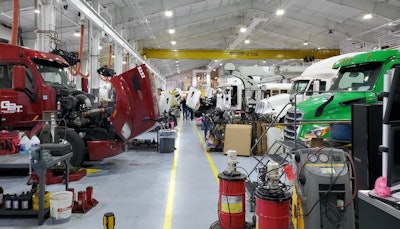 Rush Truck Center, San Antonio
Rush Truck Center, San AntonioIn the third quarter, Rush Enterprises achieved revenues of $1.18 billion and net income of $33.9 million for the third quarter ended Sept. 30, 2020, compared with revenues of $1.6 billion and net income of $39.1 million in the same period last year.
The ongoing COVID-19 pandemic and the anticipated industry downturn had a negative impact on the company’s third quarter results, it experienced an improvement in revenues and profitability from the second quarter of 2020, according to W.M. “Rusty” Rush, chairman, CEO and president, Rush Enterprises.
The revenue increase primarily was driven by a significant improvement in truck sales compared with the previous quarter. Strong consumer spending throughout the country significantly increased demand for freight services and spot market rates which resulted in improved Class 8 new truck sales, Rush says.
“Further, we implemented robust cost management measures both before and during the pandemic and we saw the full effect of those measures in the third quarter. These actions helped us to improve profitability and contributed to an absorption ratio of 119.4 percent, despite significantly reduced parts and service revenues compared with the third quarter of 2019,” he says.
The company says, while many uncertainties remain, it continues to expect that any economic recovery will be gradual. However, the company says it was encouraged by its third quarter results.
While the COVID-19 pandemic continues to have a significant negative impact on the company’s financial results, increased consumer spending in the third quarter, due in part to government stimulus payments and increased demand for transportation services was a positive.
“This helped improve our overall financial results compared to the second quarter. Although our third quarter financial results were encouraging, many uncertainties about the pandemic and the economy in general remain and we continue to believe the pandemic will have a significant effect on our business for the foreseeable future,” says Rush.
Starting in the fourth quarter of 2019 and continuing into the second quarter of 2020, the company implemented rapid and widespread cost reduction measures to help navigate the conditions brought on by the anticipated industry downturn and unanticipated COVID-19 pandemic.
“Our expense reductions were fully implemented in the first half of this year, so our third quarter results reflect a full three months with those measures in place. We remain confident that we are sized appropriately to support our customers while maintaining our financial strength,” Rush says.
Aftermarket products and services
Aftermarket products and services accounted for approximately 66.8 percent of the company’s total gross profits in the third quarter, with parts, service and collision center revenues totaling $400.3 million, down 12 percent compared with the third quarter of 2019. The company achieved a quarterly absorption ratio of 119.4 percent in the third quarter of 2020.
“Our aftermarket activity remained relatively flat from April through July, but picked up somewhat in August and September, leading to a 6 percent increase in aftermarket revenues in the third quarter compared with the second quarter. Our service revenues increased by 2.4 percent over the prior quarter while our parts sales revenues increased by 8.6 percent over the second quarter. This revenue growth was driven by steady demand from a variety of market segments, particularly refuse, construction and over-the-road customers. Further, employees in all areas of the company have done a fantastic job managing expenses, which directly contributed not only to our strong absorption ratio, but also to our overall aftermarket success this quarter,” Rush says.
“As we look ahead, uncertainties remain about the pandemic and our country’s economic recovery. Additionally, activity from the energy market remains significantly lower than normal and is not expected to recover any time soon. That said, our aftermarket business has strengthened in the past few months. Though we expect some seasonal softness through the winter, which is normal for our business, we are cautiously optimistic that consumer ecommerce spending will continue to drive increased freight demand and soften the normal seasonal decline. Regardless, we believe our aftermarket business will continue to recover gradually for the foreseeable future,” he says.
Commercial Vehicle Sales
The company sold 2,584 new Class 8 trucks in the third quarter and accounted for 5 percent of the new U.S. Class 8 truck market.

“With government stimulus payments strengthening consumer spending, freight increased significantly across the country in the third quarter. Spot rates were among the highest in history, which increased demand for new Class 8 trucks. Due to manufacturing shutdowns in the second quarter, the availability of new trucks off the production line was limited, and as a result, stock truck sales increased in the third quarter compared to the second quarter. Our stock truck inventory has declined somewhat, which is consistent with what the industry is experiencing. Due to healthy order intake in the third quarter, we expect our new Class 8 truck sales in the fourth quarter to be similar to our results in the third quarter,” says Rush.
The company sold 2,941 new Class 4-7 medium-duty commercial vehicles in the third quarter of 2020, accounting for 4.8 percent of the total U.S.
“Our second quarter Class 4-7 new commercial vehicle sales were impacted by the COVID-19 pandemic, but similar to our Class 8 new truck sales, we experienced a noteworthy increase in unit sales of 26 percent compared with the second quarter of 2020. This increase was largely driven by landscaping, residential construction and other small businesses assisted by government stimulus payments and state re-openings,” Rush says.
“We believe our fourth quarter new medium-duty commercial vehicle sales will be consistent with our third-quarter commercial vehicle sales, and that in general, medium-duty commercial vehicle sales will continue to be directly impacted by the COVID-19 pandemic and uncertainties about the economy,” he says.
Learn how to move your used trucks faster
With unsold used inventory depreciating at a rate of more than 2% monthly, efficient inventory turnover is a must for dealers. Download this eBook, “Sold! Best Practices for Moving Used Trucks,” to access proven strategies for selling used trucks faster.
The company sold 2,055 used commercial vehicles in the third quarter of 2020, a 10 percent increase compared with the third quarter of 2019.
“Production shutdowns earlier this year limited the access to new commercial vehicles available for sale in the third quarter. That, along with healthy freight movement and strong spot rates, resulted in increased demand and improved values for used commercial vehicles. Our used commercial vehicle sales improved in the third quarter, and while we expect some normal seasonal decline, we believe our fourth quarter used commercial vehicle sales will remain solid,” says Rush.
Financial highlights
Parts, service and collision center revenues were $400.3 million in the third quarter of 2020, compared with $454.8 million in the third quarter of 2019. The company delivered 2,584 new heavy-duty trucks, 2,941 new medium-duty commercial vehicles, 283 new light-duty commercial vehicles and 2,055 used commercial vehicles during the third quarter of 2020, compared with 4,318 new heavy-duty trucks, 4,566 new medium-duty commercial vehicles, 525 new light-duty commercial vehicles and 1,868 used commercial vehicles during the third quarter of 2019.
For additional earnings information, CLICK HERE.












